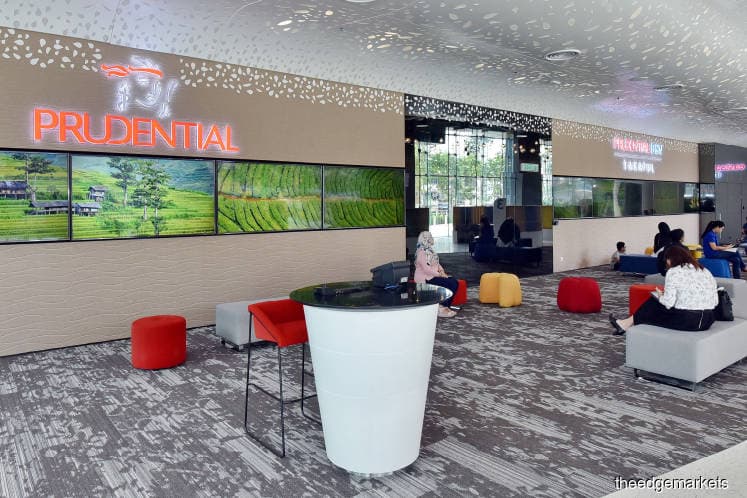
This article first appeared in The Edge Malaysia Weekly on May 4, 2020 - May 10, 2020
FOR veteran insurance agents who are still actively servicing their clients today, things have certainly changed. Long gone are the days of carrying around stacks of pamphlets, policy books and forms when meeting clients, as all the information required can now be stored in a sleek electronic tablet.
And that is how the age-old insurance industry has embraced technology, and insurtech — the use of technology to optimise the performance of insurance companies — has now become a way of doing business, at least for firms that have invested time and money into digitally transforming their business models.
One such insurance provider is Prudential Assurance Malaysia Bhd, which began its digital transformation journey in 2014 and has spent RM250 million over the last four years on such initiatives. Its chief transformation and operations officer, Teh Kim Leng, shares that the group started out with the development of its five-year Technology Modernisation Plan, the objective of which was “to build a solid and scalable IT foundation to address and support our business needs through simplification and enhancement of IT system capabilities”.
The plan was anchored in three key business imperatives — improving speed to market to launch products and services; organisational agility to respond to constant regulatory and market changes; and driving a greater level of operational efficiency to prepare for the digital world.
“This has allowed us to provide our customers with better experiences, which has had a positive impact on our business,” Teh tells The Edge. He, however, acknowledges that industry players have yet to explore the full potential of insurtech.
“Innovative technologies are disrupting the way we do things, but they can also improve the very same processes and efficiencies that are holding us back. For Prudential, we are embracing this change and integrating technology into our business practice while making the process of insurance easier and more convenient for all our stakeholders — customers, employees and wealth planners,” says Teh.
From an agency standpoint, there are many technologies that allow wealth planners to work more easily and efficiently, says Chai Koh Min, general manager of agency distribution at Prudential. “This change is a positive one for us. People may think this digital convenience would be a threat to wealth planners, but it actually complements their work as it makes it easier to have conversations and also reduces the inconvenience for potential customers who do not want to deal with too many procedures.”
Among the key technology initiatives driving Prudential’s transformation is Pulse by Prudential, an all-in-one digital app and the first-of-its-kind to offer holistic health management to Malaysians. The app recently achieved one million downloads.
Teh says Malaysia was the first market the group introduced Pulse to, as it believes the country is well positioned to lead the digital healthcare revolution because of its youthful population with an average age of 28 years as well as high daily internet, smartphone and app usage.
During the Movement Control Order period, wealth planners have also been provided with tools that allow them to conduct remote sales via the PRUWay Plus (point-of-sale) app.
Having the right partners in the digital age is also important, says Teh. For example, Prudential’s partnership with Boost — a leading lifestyle e-wallet in Malaysia — provides its customers with “a seamless, secure and convenient” way to pay their premiums, he points out.
On insurers that are reluctant or slower to adopt the use of technology, Teh and Chai agree that cultural or behavioural change is the biggest challenge most organisations face in pursuing their digital strategies.
“That is why engagement is crucial in ensuring our key stakeholders are also our partners in our digital transformation journey. We need to continually communicate our efforts to them, so they are aligned with our efforts,” says Teh.
“Another big challenge is the lack of capability to adapt to future operating models. As new technologies and tools come onto the market, insurers have a hard time including or implementing them in their technology stack because of outdated legacy systems.
“It’s also hard to replace legacy systems. Not only is it expensive to do so, there are also risks involved. Enterprises could lose valuable information and even disrupt critical business operations, which is why most insurers are reluctant to move off their legacy systems,” he adds.
Chai says there is also the perception that with the rise of technology, wealth planners may become redundant as potential customers can find what they want online themselves.
“On the contrary, we believe that technology can improve and enhance the performance of wealth planners. A perfect example of this is Pulse, which helps us remain relevant and top of our customers’ minds as they go through various stages of their health journey. This greatly helps our wealth planners to meaningfully engage their current and prospective customers.
“Nevertheless, insurance remains a ‘people’ business. We believe strongly in the value of personal interaction and professional sales advice — they are critical to the purchase of insurance. The role of our agency force will continue to be central to customer engagement.”
Moving forward, Teh says Prudential’s focus will be on closing the protection gap among Malaysians. “Only 40% of the population is covered by life insurance or takaful plans. This shows a severe lack of awareness on the importance and value of protection.
“This is where digitalisation comes in, as an enabler for us to reach out to more Malaysians and provide them with financial freedom and peace of mind.”
Save by subscribing to us for your print and/or digital copy.
P/S: The Edge is also available on Apple's AppStore and Androids' Google Play.